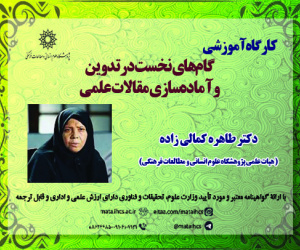تحلیل ساختاری و زیبایی شناختی چهارشومینه سرامیکی منقوش از دوره قاجار اثر استاد علی محمد اصفهانی (مقاله علمی وزارت علوم)
درجه علمی: نشریه علمی (وزارت علوم)
آرشیو
چکیده
استفاده از بخاری دیواری در فضای داخلی معماری ایران، دارای دو رویکرد کاربردی و تزئینی بوده است. از اواخر قاجار شومینه هایی با پوشش سرامیک رواج پیدا کرده که با موضوعات بزمی و رزمی نقاشی شده و بیشتر آنها فاقد امضا می باشند. در این مقاله چهار نمونه ساخته علیمحمد اصفهانی کاشی ساز دوره قاجار معرفی و از لحاظ نقوش، رنگ و تکنیک بررسی شده اند. آثار وی دارای ویژگیهای منحصر به فردیست که آن را از سایر نمونه های هم عصرش متمایز می کند. بر این اساس هدف تحقیق شناسایی و معرفی شومینه های سرامیکی ساخته این هنرمند است و پرسش این است که این نقاشی ها چه ویژگیهای متفاوتی از لحاظ فنی و هنری دارند؟ و آیا شومینه موزه مقدم نیز،ساخته علیمحمد است؟ اطلاعات بصورت کتابخانه ای و میدانی گرد آمده و بصورت توصیفی و تحلیلی، در بین چهار نمونه باقی مانده از آثار با امضا یا بدون امضای این هنرمند، با رویکردی تاریخی مورد بررسی قرار گرفته اند. یافته های این تحقیق نشان می دهد تاکنون اولین شومینه سرامیکی تاریخدار، ساخته علیمحمد بوده و آثار او در هر دو سبک صفوی و قاجار، کار شده اند. با قرائن سبک شناسی، شومینه موزه مقدم نیز اثر همین هنرمند میباشد.Structural and aesthetic analysis of four painted ceramic Chimney, Works by Master Ali-Mohammad Isfahani
There have remained a few chimneys from Qajar period dispersed inside Iran and abroad. It seems that they have been produced in two or three tile production workshops in Tehran or Isfahan. Therefore, the main question of the present research is that what are the most important technical and artistic features of chimneys that have been made by Master Ali-Mohammad Isfahani? Furthermore, has the chimney in the Moghadam Museum been made by the same tilemaker? The chief goal of this research is to identify and introduce those chimneys produced by Ali-Mohammad Isfahani.
Ali-Mohammad is a renowned and prolific tile maker in this period who wrote a treatise by order of the Major Robert Murdoch Smith on tile making and ceramics. His works are now preserved in many museums, including the V & A, as well as in impressive buildings inside and outside Iran. He immigrated to Tehran from Isfahan in 1301 AH/1883-84 AD at the recommendation of Smith, the then head of Telegraph Department, setting up a workshop near the Shah Abdol-Azim Gate, in the south of Tehran. We have little evidence from his life and artistic activity at Isfahan. No signed tile by him has been observed at Isfahan. Murdoch Smith visited him twice while travelling to that city. In his second travel, he was astonished by this young artist’s works and admired him. That event was a new page in the professional life of Ali-Mohammad, because Smith and other Europeans such as Monsieur Lemaire, the musician who taught at Dar-ol-Fanoun (the Qajar Poly technique School), brought about the development and establishment of his career at Tehran. Consequently, his works and his workshop became so famous in a short time that other great masters, e.g. Master Mostafa, visited there frequently.
The signed works by Ali-Mohammad are not few. Such a level of production indicates that his workshop has been the most important place in making painted tiles, tiled panels, ceramics and glazed. This article studies, four tiled chimneys by Master Ali-Mohammad by gathering data from textual sources, internet, as well as field research. It should be be pointed out here that the technical aspects of such chimneys, their constructions and heating systems have not been taken into consideration as a result of considering aesthetics and art matters. Now two of chimneys are in Olana State Historic Site, New York; one is preserved in the V & A Museum (only its border is on display without any other tiles). The fourth ceramic chimney, preserved at the Moghadam Museum, is attributed to Ali-Mohammad and bears no sign. The findings of this research prove that this piece has been made by Ali-Mohammad. Regarding this master’s professional background as a mason, ceramic chimneys should be considered one of his own innovations. Other artisans must have followed this trend making such tiled chimneys in this artist’s workshop, since there was mass production of molded tiles for dados in that place. All other chimneys of this type have been flanked by such tiles on either side.









